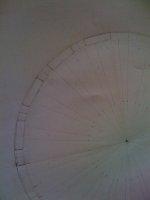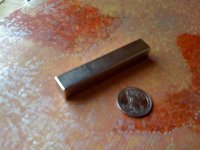BigOutrunner
1 W
- Joined
- Mar 31, 2013
- Messages
- 52
Hello All!
I'm a newbie to ES, and I'm experimenting on a roughly 15 inch diameter, 3 inch wide outrunner shaped as a ring.
The magnets I'm using are N42 and I have 16 effective poles on the rotor.
The magnet dimension is approximately 3 inches wide, 2 inches in length and 3/8 of an inch thick.
I'm going to match this with 18 effective stator teeth (still attempting to optimize the stator design).
I'm aiming to make the entire thing as light but as torquey/fast as possible.
Will Litz wiring be a good choice for the stator windings for this application?
I'm trying to make the windings as compact as possible - only around 1 inch thick.
I've seen the triple axial flux winding on acrylic glass build on ES (Awesome!).
So perhaps I can attempt something similar (air core) to keep the weight down, but that will likely reduce torque?
Most of the formulas I've encountered don't seem applicable to a outrunner ring design, can anyone offer an estimate of the max torque/speed that this basic design can produce with the controllers (i.e. AC Propulsion, etc.) available today (assuming max possible voltage for brief durations)?
I understand that there are technical limitations with regard to BLDC controllers when the motors are this size. What should I look out for?
Any comments and suggestions would be greatly appreciated. ES is a terrific resource. I've spent weeks on here learning.
I hope to post photos and videos of the build but right now, it is very early days.
My apologies again if my questions are too basic.
Thanks all!
BigOutrunner
I'm a newbie to ES, and I'm experimenting on a roughly 15 inch diameter, 3 inch wide outrunner shaped as a ring.
The magnets I'm using are N42 and I have 16 effective poles on the rotor.
The magnet dimension is approximately 3 inches wide, 2 inches in length and 3/8 of an inch thick.
I'm going to match this with 18 effective stator teeth (still attempting to optimize the stator design).
I'm aiming to make the entire thing as light but as torquey/fast as possible.
Will Litz wiring be a good choice for the stator windings for this application?
I'm trying to make the windings as compact as possible - only around 1 inch thick.
I've seen the triple axial flux winding on acrylic glass build on ES (Awesome!).
So perhaps I can attempt something similar (air core) to keep the weight down, but that will likely reduce torque?
Most of the formulas I've encountered don't seem applicable to a outrunner ring design, can anyone offer an estimate of the max torque/speed that this basic design can produce with the controllers (i.e. AC Propulsion, etc.) available today (assuming max possible voltage for brief durations)?
I understand that there are technical limitations with regard to BLDC controllers when the motors are this size. What should I look out for?
Any comments and suggestions would be greatly appreciated. ES is a terrific resource. I've spent weeks on here learning.
I hope to post photos and videos of the build but right now, it is very early days.
My apologies again if my questions are too basic.
Thanks all!
BigOutrunner





